Clayton, West Sussex – 1150-1200
Christ in Majesty (Maestà), with Judgement details
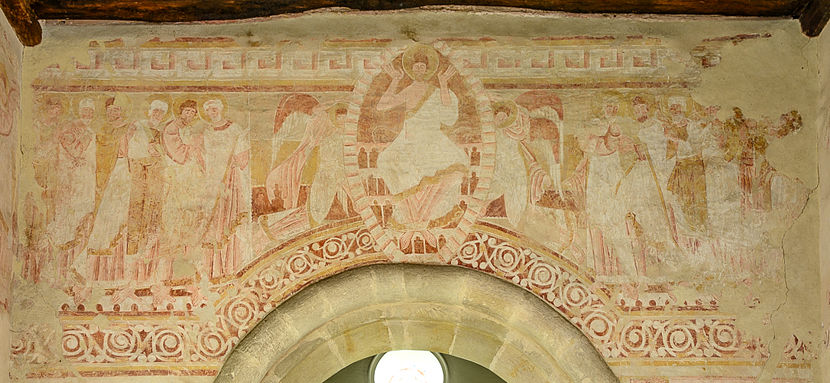
The magnificent paintings of Christ in Majesty, with full Judgement details, at Clayton are some of the finest in the country, and many of the detailed individual scenes are virtually intact. Most of them are shown in the various photographs below. But the main focus is of course on the chancel arch, shown above, where Christ presides within a central mandorla. Two angels flank the mandorla, and the Apostles, six on either side, stand beyond.
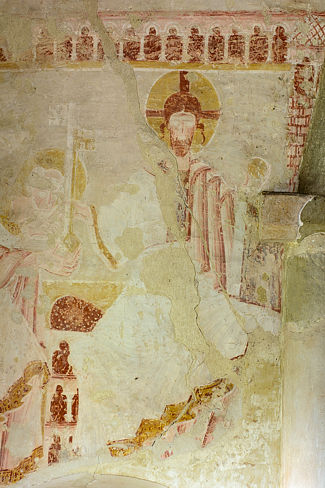
In the tier below this, Peter and Paul feature as recipients of, respectively, the Keys of Heaven and the Book. Peter is at the left (photo, right), kneeling as Christ, who has a cruciform halo and faces outwards into the church, hands him a very large key. Greek influence, typical of paintings of this early date and showing everywhere at Clayton, is particularly marked in the physiognomy here.
The sometimes misleading label ‘Traditio Legis’ meaning literally ‘translation of authority’ is often given to this particular iconographic detail, but I know of no similar label attached to the Giving of the Book to Paul, which occupies the corresponding position on the right of the mandorla and is shown here below at the left. Christ, now on the left of the subject and with right hand raised in blessing, extends his left towards Paul, whose traditionally bald head is bowed. The sizeable object he holds seems indeed to be a book, although the detail is unclear.
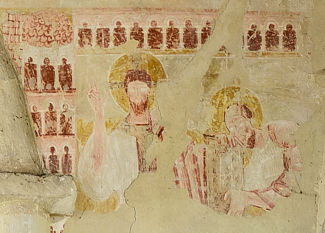
The general association between Peter and Paul as founders of the Church is discussed further on the page for the Baptism of Christ/SS Peter & Paul at Black Bourton in Oxfordshire, but the theology behind the specific treatment at Clayton probably comes, as Tristram suggested¹ from a Cluniac tradition of special devotion to the two saints. In the eleventh and twelfth centuries, the influence of the monastery of Cluny spread far and wide from the original foundation in Burgundy, and a group of paintings (‘the Lewes Priory school’) in Sussex, including those at Hardham², West Chiltington and Coombes all show this to some extent.
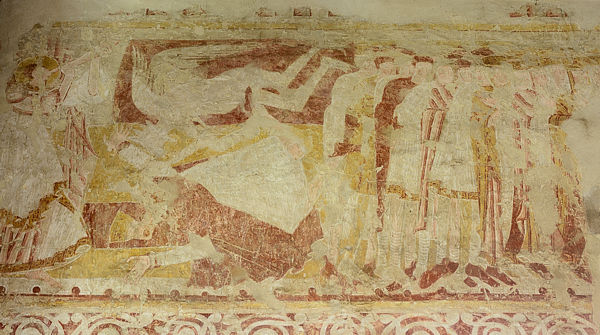
The Judgement narrative proper begins on the north wall with an angel, standing upright, sounding a trumpet (photo, right). Beyond this to the right, another angel flies horizontally across the upper part of the picture space, apparently casting to the ground a figure who lies with right arm extended. In fact there may be more than one fallen or falling figure here, but the details are confused, and all that can be said with safety is that this is the defeat of some damned personage, possibly a specific one (Antichrist, for example), or possibly a representative figure standing for all those condemned at the Judgement.

Beyond this a group of figures in short tunics represents the Blessed; further beyond and shown in the photograph at the left, the two Abbots or Bishops who lead this group are welcomed by two angels who lead them and the group towards Paradise.
Paradise is here (below, right) a walled city, hexagonal, with tiered arcades giving the effect of a cloister, towers, and a dome beyond. Within stand three figures, hands raised in adoration, and an angel stands at the far right, outside the walls. According to Tristram the ground on which the three figures stand was once painted green, implying that this is a garden within a city. Heaven is depicted in a variety of intriguing ways in English paintings of the Last Judgement or Doom, such as that at South Leigh in Oxfordshire, but this particular treatment is, I think, unique.
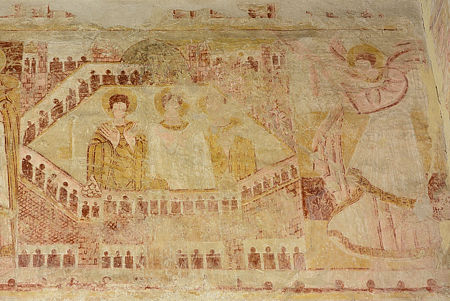
Finally, what is in many ways the most interesting scene of all is on the south wall, after a badly damaged group of angels carrying the Instruments of the Passion (not shown here). It is incomplete, but pictured at the lowest left here, and shows a horseman in a white close-fitting tunic and what seems to be a short loincloth, possibly with an intentionally ragged edge.
He is gesturing to the left, where a group of the Blessed stand, but riding towards the right, and another group of people. The detail is very faint, but it is just possible to make out an obviously desperate pair of pinkish upstretched hands between the two front legs of the horse. Presumably this is a figure who has been ridden down by the horseman, which might explain why the huddled group at the right has such an apprehensive air. At the far end of the south wall, and not shown here, is a trumpeting angel matching that on the north shown above.
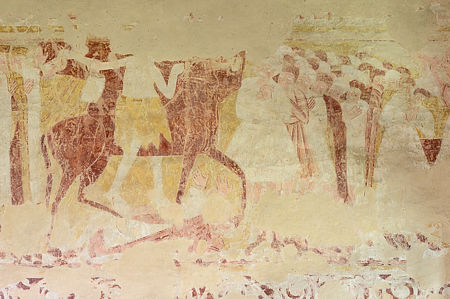
What it all means, of course, is highly problematic. Tristram suggested that this might be the first of the four horseman of the Apocalypse,³ made famous as a subject later by Albrecht Dürer among others, and it is obvious enough that these are apocalyptic scenes and incidents of some kind, based, no doubt, on some of the details in Revelation. But given the complexity and the often enigmatic nature of the narratives there, to say nothing of the passage of time since they were interpreted by, or for, the Clayton painter, it seems unlikely that we will ever be able to say much more than this.
Not everything is shown here – some scenes are very faint or badly damaged now, and a whole tier of painting below those shown here has disappeared almost completely. Tristram has drawings of some of these, including a Weighing of Souls and some fragments showing the Rising Dead, a devil or two, flames – enough at least to suggest that these particular aspects were treated in the conventional manner familiar from later examples of the subject.
At all events, the paintings at Clayton are without a doubt some of the most fascinating to be found anywhere, and it will be obvious from the photographs that they are also some of the most accomplished.
You can see a 360° panorama of the interior of the church here.
Website for St John the Baptist, Clayton
¹ Tristram 1, p.114
² The chancel paintings at Hardham – the only ones from the church currently on the site – are in a different, native tradition, as discussed on the relevant page. But the differences are themselves instructive.
³ Tristram 1, p.115
Photos © Roy Reed 2019